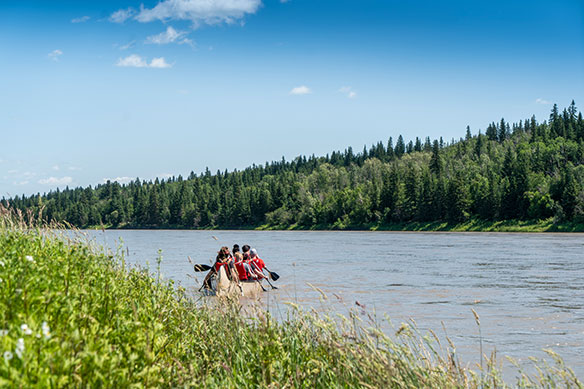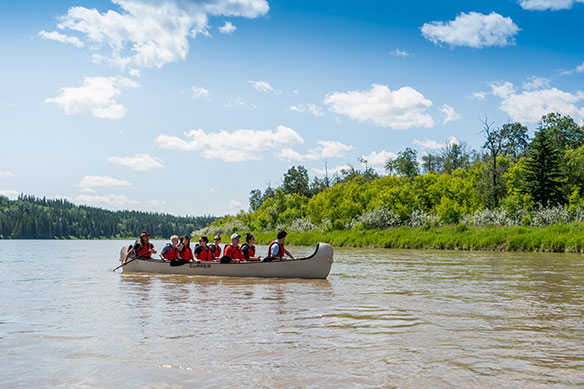
Paddle into the past with Metis Crossing
IAN STALKER
Smoky Lake, Alta.’s Metis Crossing is looking forward to again offering canoeing enthusiasts waterborne history lessons about those who played a crucial role in the shaping of the West; without having the modern-day paddlers experience any of the hardships that were routinely all part of a day’s work for ancestors of Metis Crossing employees.
Metis Crossing – described as “Alberta’s first major Métis cultural interpretive destination” and found a little over an hour northeast of Edmonton – includes among its programs Paddle into the Past, a spring and summer offering, although this year the company pivoted in order to keep its doors open and safely welcome the public to its premier destination during the coronavirus pandemic.
This year it has been offering a Meet the Métis program throughout the summer that allowed families and friends to remain together and separated from other groups while still learning and experiencing Métis history and culture.
It hopes to be able to offer Paddle into the Past next summer and spring if it is safe to do so.
Paddle Into the Past has participants travel 5 kilometers on excursions of around four hours on the North Saskatchewan River in 22-foot-long canoes that hold eight people and recall the massive canoes the voyageurs – who were frequently Metis – used as they paddled and portaged across much of what is now Canada centuries ago as part of the fur trade.
Life of a Voyageur
The voyageurs were famed for their hardiness, spending long days paddling and carrying their heavy canoes from one river to another.
Krista Leddy, Metis Crossing›s experience development coordinator, says Paddle into the Past gives participants insights into the voyageur lifestyle while sparing them the hardships that the voyageurs – often French-speaking explorers who married Indigenous women or descendants of such couples – faced on their long journeys between the West and cities in the East from which the furs they returned with were often exported to Europe.
“Through this immersive experience, you will learn the importance of canoeing and portaging to the Métis Community in just a short amount of time,” Leddy says. “Because the canoes are very lightweight and stable, they are very easy to paddle.
It is also important to keep in mind that you are floating on the river – which helps out a lot. The trips are guided with a certified guide on each canoe.”
Leddy says the large canoes provide a different paddling experience than what people are generally used to, with regular canoes having a smaller turning radius, while the larger ones take a «little more teamwork to steer. With that being said, a larger canoe is very hard to tip over, making for a smoother ride.”
Remarkable stories
Métis Crossing sits on the Victoria Settlement historical site – 512-acres of land comprising river lot titles from the original Métis settlers to the region in the 19th century. Families that settled near Métis Crossing have links to what was an area Hudson Bay Company trading post found on a historic fur trading route.
Leddy says the voyageurs were incredibly important to the history of this country “as they created communities that opened up the West and were able to help map out the area for trading.
“Life was difficult, hard work and full of pitfalls for the original voyageurs. They could easily get hurt, had to watch out for animals and battle the cold. However, many of them did have a fairly good lifestyle, especially if they spoke multiple languages. There are lots of stories of how they reached Northern Alberta and even trading posts beyond!”
Leddy says her own family history includes voyageurs who worked their way from Hudson Bay to what is now Alberta. “They created lives that thrived from living from the land and we are very proud of the understanding that they had to believe that everything is connected to the land and that we are all connected as people. It is also important to note that not all Métis families originate from voyageurs, but many of the families had roles that supported the skills of the traders.”
She says the Métis have a distinct Indigenous story to tell. “That is the story we are thrilled to share with visitors to Métis Crossing.
“We believe there are significant opportunities to educate and share our culture with the public. This is a true opportunity at Métis Crossing – we’re excited about sharing our culture and history through unique programming – whether it be for groups, individuals, schools, or corporate teams.”
More information can be found at metiscrossing.com.


